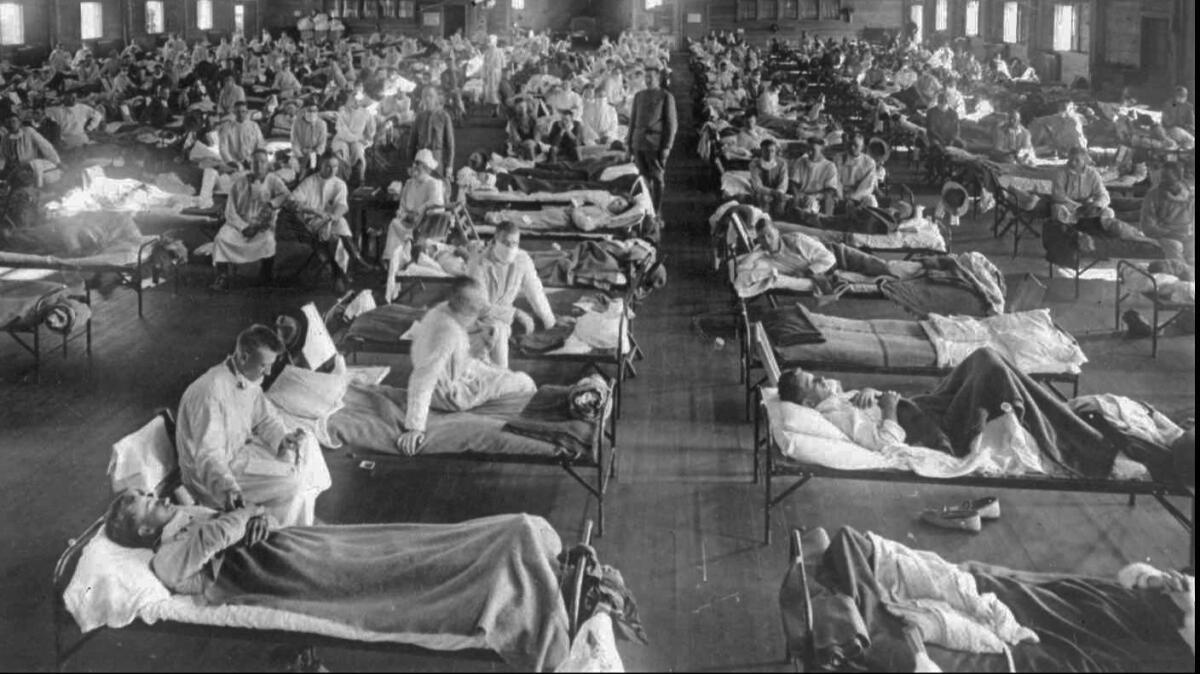COVID-19 is not your great-grandfather’s flu. Comparisons with 1918 are overblown

- Share via
Comparisons between the current coronavirus pandemic and the 1918 flu that similarly swept the world are inevitable, and there are some striking parallels. But there are also important differences.
Both diseases spread across the globe with stunning rapidity. In the autumn of 1918, for example, it took the influenza just eight weeks to spread across the entire United States. Both illnesses killed a significantly higher percentage of their victims than “ordinary” seasonal flus. And politics have played a large role in the way information about both diseases was disseminated (or not). In 1918, as World War I drew to a close, federal officials hesitated to order quarantines because flu outbreaks threatened America’s patriotic spirit (and spending).
But while these likenesses — and many others — are real, this is not your great-grandfather’s pandemic, and that’s a good thing.
First, no one knew what caused the 1918 disease. The idea that exposure to a disease could render the survivor immune to future infections, and that vaccination was possible for some diseases, was known. But even the best scientists of the time knew little about viruses, and without understanding the infectious agent, scientists were flying blind. They desperately tested possible “vaccines” and treatments, injecting hundreds of thousands of workers, soldiers and citizens with mixtures of dead bacteria sourced from the morgue as well as the lab.

The 1918 flu was one the worst pandemics in history, infecting one-third of the world’s population. How cities responded to the crisis in 1918 provides lessons on handling COVID-19 today.
They used bacteria because in the 1890s, after a previous flu epidemic, microbiologist Richard Pfeiffer isolated a bacterium, “Pfeiffer’s bacillus,” that he asserted was the cause of influenza. He was wrong; it merely followed the virus through the ravaged lungs. (Later, this bacillus was renamed Haemophilus influenzae, which causes secondary bacterial pneumonia.)
A century later, not only do we know that a virus causes COVID-19, but scientists have already sequenced the genome of the virus, providing information crucial to developing an effective vaccine and treatments.
In our “Dispatches From the Pandemic” series, we bring you personal stories from people whose lives have been altered by COVID-19.
Second, although the mortality of both pandemics is higher than the seasonal flu, which group of people dies differs. Seasonal influenza is usually most deadly to young children and the elderly. The 1918 flu was similarly deadly to those populations, but it also killed people ages 20 to 40. In contrast, SARS-COV2 is most deadly to the elderly, less so to young adults, and much less so to children.
To understand the reason for the high virulence of the 1918 flu, it helps to think about things from the virus’ perspective. Viruses evolve just like all living beings, and for a virus to spread its genes, it must travel from one infected individual to another. Under most circumstances, making the host sick, but not too sick to move around and pass on the illness, gives the virus an advantage; a host who is bedridden (or isolated) can’t deliver infectious, virus-containing particles to as many new hosts.
But Europeans and North Americans in 1918 weren’t living under ordinary circumstances. In the trenches and transports of World War I, extreme crowding meant that from the virus’ perspective, it didn’t matter if it killed its host immediately — a fresh victim was literally inches away. That, according to some scientists, is how the 1918 flu evolved to be so damaging even to young, healthy individuals. After the war, when crowding dissipated, the flu virus had to go back to infecting hosts who weren’t crowded together, so it was no longer evolutionarily desirable for the virus to be so virulent. How the current environment changes the coronavirus and its severity remains to be seen, but we can be sure that evolution will play a part.
Finally, the speed of scientific communication has changed dramatically. In 1918, the fastest messages moved by telegraph and the new “wireless” technology of radio, but scientists and physicians mainly published their results in journals that took months to print and disseminate. In December 2019, Chinese scientists shared the results of their genomic studies on SARS-COV2 on the internet, and within hours, labs around the world were using the data to begin vaccine development. And when solutions to the crisis come, we can expect them to be communicated worldwide nearly immediately.
This is not to say everyone is behaving altruistically; scientists, and their governments, are subject to plenty of partisan competitiveness and other counterproductive moves. But we believe that the way this pandemic is being faced will change how we respond to similar threats for many years to come.
Infectious disease modeler Adam Kucharski says his colleagues have a saying: “If you’ve seen one pandemic, you’ve seen … one pandemic.” To invoke a more hackneyed saying, what we have learned since the 1918 flu means we won’t be condemned to repeat it.
Marlene Zuk is an evolutionary biologist at the University of Minnesota and author of “Paleofantasy: What Evolution Really Tells Us About Sex, Diet and How We Live.”
Susan D. Jones is a veterinarian and professor of the history of science at the University of Minnesota and author of “Death in a Small Package: A Short History of Anthrax.”
More to Read
A cure for the common opinion
Get thought-provoking perspectives with our weekly newsletter.
You may occasionally receive promotional content from the Los Angeles Times.










